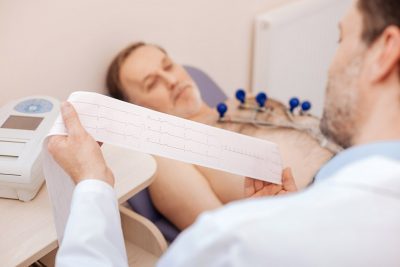
Arrhythmia Recurrence After Catheter Ablation of Atrial Fibrillation
April 1, 2025
By Michael H. Crawford, MD, Editor
Synopsis: An integrated nationwide medical and pharmacy claims database analysis of patients with new atrial fibrillation undergoing catheter ablation as first-line therapy has shown that 17% of patients required repeat ablation for recurrent atrial fibrillation despite the frequent use of antiarrhythmic drugs.
Source: Saksena S, Ken-Opurum J, Mckindley DS, et al. Arrhythmia recurrence and rhythm control strategies after catheter ablation of newly diagnosed atrial fibrillation (ARRC-AF study). JACC Clin Electrophysiol. 2025; Jan 7. doi: 10.1016/j.jacep.2024.11.020. [Online ahead of print].
Catheter ablation is a first-line treatment option for patients with new atrial fibrillation (AF). However, there is a paucity of data on the necessity for the addition of antiarrhythmic drugs, especially in patients who undergo repeated ablations. To explore these issues further, the Optum Market Clarity (OMC) database, which links medical records with pharmacy records, was queried to evaluate rhythm control strategies in patients who had new AF initially treated by ablation. Also studied were the rate of repeat ablation, the recurrence of AF (or atrial flutter), and the use of concomitant antiarrhythmic drug therapy (ADT). In addition, the clinical characteristics of those requiring repeat ablation were assessed.
The OMC database includes more than 80 million patients with commercial insurance or Medicare. The investigators identified 2,429,863 adults with new AF and at least 12 months of follow-up who had an AF ablation. The researchers excluded those with permanent AF, AV node ablation, or surgical ablation (maze procedure). The resulting population of 23,323 patients (mean age 63 years, 67% men, 92% white, 52% obese, 52% hypertension) were followed until death, disenrollment, or study end. Data analysis excluded the first three months after ablation. The mean time from AF diagnosis to ablation was 400 days and the median follow-up duration for all patients was 3.2 years.
Repeat ablations were done in 17% of patients, most of which were second ablations (14%), but 2.4% had three or more ablations. ADT use was common after the first ablation (47%) and increased after the second ablation to about two-thirds of patients. The most frequently used drug was amiodarone, whose use increased progressively after each ablation from 15% after the first ablation to 40% after four or more ablations. Repeat ablation was associated with AF phenotype: chronic vs. paroxysmal incidence rate ratio (IRR), 2.26 (95% confidence interval [CI], 1.27-3.68); ADT use vs. no use IRR, 1.42 (95% CI, 1.30-1.56); obstructive sleep apnea IRR, 1.26 (95% CI, 1.20-1.33); valvular heart disease IRR, 1.12 (95% CI, 1.07-1.18); coronary artery disease IRR, 1.13 (95% CI, 1.07-1.19); and body mass index ≥ 30 kg/m² IRR, 1.10 (95% CI, 1.02-1.20). The authors concluded that one in six patients with new AF treated by ablation had repeat ablation, and almost half of these patients also were treated with ADT.
Commentary
AF is the low back pain of cardiology. It is common, often symptomatic, and the treatment options are unpleasant and dangerous. In my institution, the electrophysiologists want general noninvasive cardiologists to see new AF patients first to control the heart rate, institute anticoagulation, and treat the underlying comorbidities. Then, if the patients still are symptomatic, they are referred to electrophysiology for more advanced therapies, such as cardioversion, ADT, or ablation. The general cardiologist usually describes these advanced therapies, so the patient knows why they are seeing the electrophysiologist. That is where the trouble starts, because ablation often is a tough sell: “They are going to put catheters into your heart and burn it,” etc. Also, ablation does not mean no anticoagulation, and now the Optum database study informs us that ADT use is not necessarily avoided and repeat ablations sometimes are needed. So, the sell just got harder.
Other studies have shown similar repeat ablation rates (10% to 21%) and the same comorbidities that predict the need for repeat ablation. What the OMC study shows is that concomitant ADT use is high in this real-world database and increases in patients requiring repeat ablations. In the subgroup with no ADT prior to their first ablation, 28% were on ADT after ablation, and after two ablations, the ADT use peaked at about 70%. Thus, the value of the OMC study is that the findings inform patient counseling regarding the use of ADT following ablation and the clinical predictors associated with recurrent AF.
There are limitations to this database study. Over the 14-year time frame of the study, there have been advances in ablation technology and changes to the clinical practice guidelines that are not considered. Also, data for reimbursement are subject to incomplete or inaccurate coding, the underreporting of comorbidities, and the inclusion of insured patients only. In addition, the OMC population overrepresents Midwestern patients and underrepresents Medicare and Black patients. By studying patients selected for ablation, a healthier population may have been included. The pharmacy part of the database does not account for whether a prescription was filled or taken. Finally, mortality was not evaluated to avoid a survivor bias with repeat ablations. Despite these limitations, the OMC study advances our knowledge of real-world patient care and systems-based practice.
Michael H. Crawford, MD, is Professor Emeritus of Medicine and Consulting Cardiologist, UCSF Health, San Francisco.